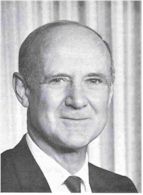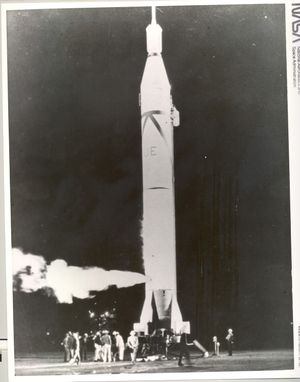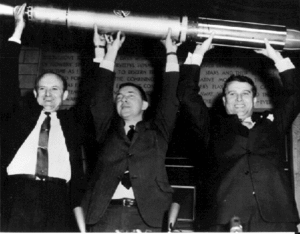William Pickering
- Birthdate
- 1910/12/24
- Birthplace
- Wellington, New Zealand
- Death date
- 2004/03/17
- Associated organizations
- MIT, NASA
- Fields of study
- Aerospace
- Awards
- IEEE Edison Medal
Biography
William H. Pickering was born 24 December 1910, in Wellington, New Zealand, and emigrated to California as a young man to attend the California Institute of Technology. There he obtained both Bachelor's (1939) and Master's (1933) degrees in Electrical Engineering and a Ph. D. in Physics (1936), became a member of the faculty, and worked under Nobel Laureate Robert A. Millikan in a worldwide program of high-altitude and cosmic ray research. During World War II he conducted applied research in electronics at Caltech, M.I.T., and other laboratories. In July 1944 he organized the electronics effort at the Jet Propulsion Laboratory (JPL) to support guided missile research and development. He became project manager for Corporal, the first operational missile developed by JPL.
Pickering was a giant in the space program that captured America’s imagination in the second half of the twentieth century and was featured multiple times on the cover of Time magazine. As JPL Director, he was involved in U.S. Army proposals for earth satellite launchings, and in 1957/58, for the development and operation of the early Explorer satellites and Pioneer space probes. Explorer I, launched January 31, 1958, was the first U.S. artificial satellite and followed Sputnik I into Earth orbit by four months. After its launch, Pickering waited in Pentagon offices with his colleagues Dr. James Van Allen and Dr. Wernher von Braun, eager for word of the satellite’s success. After they heard Explorer had made its first orbit, they held a jubilant press conference.
Pickering then helped America reach the moon. Following the early satellite projects, Pickering led JPL into the new National Aeronautics and Space Administration as a major contractor responsible for unmanned lunar and planetary flight projects and the supporting science and technology. JPL managed unmanned lunar flight projects for NASA which preceded the manned Apollo moon landings: the Ranger lunar photo-reconnaissance missions in 1964/65 and the Surveyor lunar soft landers of 1966/68.
Pickering’s work introduced Americans to the wonders of the solar system. The Laboratory also initiated interplanetary space flight in 1962 with the Mariner II mission to Venus. Mariner II revealed an 800 degree Fahrenheit surface temperature. Five years later, Mariner V data contributed to the revelation that Venus' atmospheric pressure is nearly 100 times greater than Earth's. Martian craters were discovered by Mariner IV in 1965, and, in 1969, Mariners VI and VII photographed Mars from an altitude of about 2000 miles providing scientists with high resolution pictures of the planet's varied and peculiar terrain.
Under Pickering's direction, Mariner 9 was launched in May 1971 on a 5 1/2 month flight to Mars, where it became the first spacecraft to orbit another planet. With a basic orbital life of 90 days, the spacecraft, in its first three weeks, had already taken historic photos of the two Martian satellites, detected signs of extensive water vapor content in the atmosphere, and identified areas of possible volcanic activity during past ages. Although an unprecedented dust storm restricted operations, it was hoped that the dust would settle sufficiently to permit photo-mapping of the surface.
Pickering retired from JPL in 1976, but continued to be active in teaching and business. He was a Professor of Electrical Engineering at Caltech from 1946 onward, but also taught engineering in Saudi Arabia in later years. He started a research company and founded an energy business, with which he was still involved at the time of his death.
Pickering published a number of articles and technical papers in the fields in which he was active. He was given an honorary knighthood by Queen Elizabeth II and the Japan Prize from the emperor of Japan. He received many other prestigious awards, including NASA's Distinguished Service Medal, the Army's Distinguished Civilian Service Award, the Columbus Gold Medal of Italy, the Prix Galabert of France, and the IEEE Edison Medal in 1972 "For contributions to telecommunications, rocket guidance and spacecraft control, and for inspiring leadership in unmanned exploration of the solar system."
He was an advisor to the University of California and the University of Washington. He was a member of the Army Scientific Advisory Panel and a charter member of the Air Force Scientific Advisory Board. Pickering was the first president of the American Institute of Aeronautics and Astronautics in 1963, and president of the International Astronautical Federation in 1965/66. He was a member of the National Academy of Sciences, and National Academy of Engineering, and the Royal Society of New Zealand, among others.
In addition to his storied career, Pickering was an expert gardener, fisherman, and archeology enthusiast. His affection for his native New Zealand persisted and his 90th birthday was celebrated at Caltech with Maori dancers.
Pickering was married to the former Muriel Bowler, and raised a son and daughter with her. Later in life, he married Inez Chapman, who survived him after he passed away on 17 March 2004, at 93.
Further Reading
John Noble Wilford, “William H. Pickering, 93, Leader in Space Exploration, Dies,” New York Times, Mar. 17, 2004.



